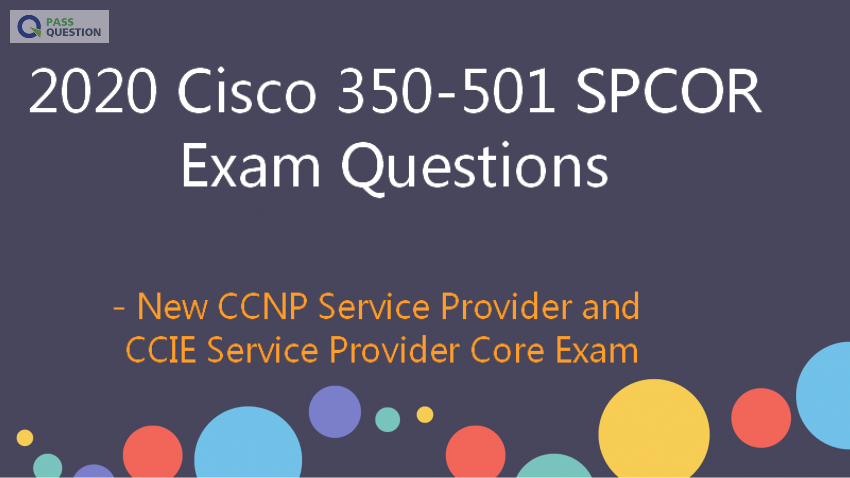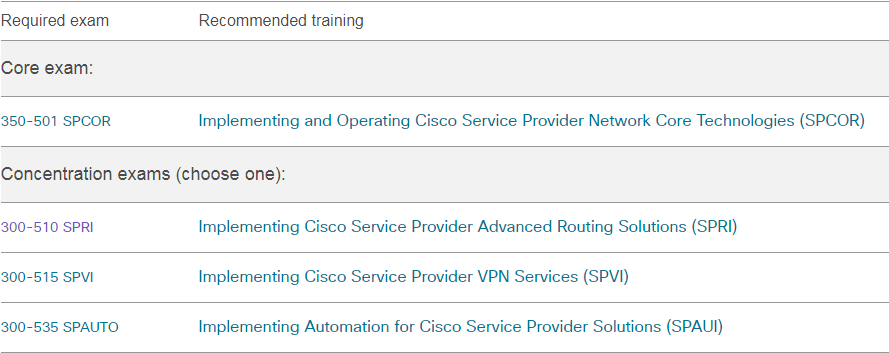2020 Cisco 350-501 SPCOR Exam Questions | New CCNP Service Provider and CCIE Service Provider Core Exam
350-501 SPCOR is the core exam of CCNP Service Provider and CCIE Service Provider certifications, if you want to pass this exam, you can choose PassQuestion Cisco 350-501 SPCOR Exam Questions to study, 350-501 questions and answers are all verified by Cisco experts who has taken this exam and passed with high score. So download the latest Cisco 350-501 SPCOR Exam Questions here and we ensure you can pass your 350-501 Implementing and Operating Cisco Service Provider Network Core Technologies v1.0 exam easily.

Cisco 350-501 SPCOR Exam Description - CCNP Service Provider and CCIE Service Provider Core Exam
The Implementing and Operating Cisco Service Provider Network Core Technologies v1.0 (SPCOR 350-501) exam is a 120-minute exam associated with the CCNP Service Provider, CCIE Service Provider, and Cisco Certified Specialist - Service Provider Core certifications.This exam tests a candidate's knowledge of implementing core service provider network technologies including core architecture, services, networking, automation, quality of services, security, and network assurance.
CCNP Service Provider and CCIE Service Provider Core Exam 350-501 SPCOR Topics
This exam tests your knowledge of implementing core service provider network technologies, including:
Core architecture
Services
Networking
Automation
Quality of services
Security
Network assurance
Share CCNP Service Provider and CCIE Service Provider Core 350-501 SPCOR Free Questions Online
1.Refer to the exhibit.

P3 and PE4 are at the edge of the service provider core and serve as ABR routers. Aggregation areas are on either side of the core.
Which statement about the architecture is true?
A. To support seamless MPLS, the BGP route reflector feature must be disabled.
B. If each area is running its own IGP, BGP must provide an end-to-end MPLS LSP.
C. If each area is running its own IGP, the ABR routers must redistribute the IGP routing table into BGP.
D. To support seamless MPLS, TDP must be used as the label protocol.
Answer: B
2.Which component is similar to an EVPN instance?
A. router distinguisher
B. MPLS label
C. IGP router ID
D. VRF
Answer: D
3.Why do Cisco MPLS TE tunnels require a link-state routing protocol?
A. The link-state database provides segmentation by area, which improves the path-selection process.
B. The link-state database provides a data repository from which the tunnel endpoints can dynamically select a source ID.
C. Link-state routing protocols use SPF calculations that the tunnel endpoints leverage to implement the tunnel.
D. The tunnel endpoints use the link-state database to evaluate the entire topology and determine the best path.
Answer: D
4.Refer to the exhibit.

BGPsec is implemented on R1, R2, R3, and R4. BGP peering is established between neighboring autonomous systems.
Which statement about implementation is true?
A. BGP updates from the iBGP peers are appended with a community of local-as.
B. BGP updates from the all BGP peers are appended with a community of no-export.
C. BGP updates from the eBGP peers are appended with an additional AS path value that is statically set by the domain administrator.
D. BGP updates from the eBGP peers are appended with a BGPsec attribute sequence that includes a public key hash and digital signature.
Answer: D
5.You are configuring MPLS traffic-engineering tunnels in the core.
Which two ways exist for the tunnel path across the core? (Choose two.)
A. The dynamic path option is supported only with IS-IS.
B. Tunnels can be configured with dynamic path or explicitly defined path.
C. A zero bandwidth tunnel is not a valid option.
D. The bandwidth statement creates a “hard” reservation on the link.
E. Tunnel links inherit IGP metrics by default unless overridden.
Answer: BE
6.Which configuration mode do you use to apply the mpls ldp graceful-restart command in IOS XE Software?
A. MPLS LDP neighbor
B. interface
C. MPLS
D. global
Answer: D
Requirements for New CCNP Service Provider and CCIE Service Provider Certification
1. To earn CCNP Service Provider, you pass two exams: a core exam and a service provider concentration exam of your choice. And now every exam in the CCNP Service Provider program earns an individual Specialist certification, so you get recognized for your accomplishments along the way.
- The core exam focuses on your knowledge of service provider infrastructure. The core exam is also the qualifying exam for CCIE Service Provider certification. Passing this exam helps toward earning both of these certifications.
- Concentration exams focus on emerging and industry-specific topics such as advanced routing, VPN services, and automation. You can prepare for concentration exams by taking their corresponding Cisco training courses.

2. Achieving CCIE Service Provider certification proves your skills with complex service provider solutions. To earn CCIE Service Provider certification, you pass two exams: a qualifying exam that covers core service provider technologies, and a hands-on lab exam that covers service provider technologies through the entire network lifecycle, from designing and deploying to operating and optimizing.
Between February 24, 2020 and April 27, 2020, to earn CCIE Service Provider, you must pass the 350-501 SPCOR exam and the CCIE Service Provider 4.1 lab exam. As of April 27, 2020, the CCIE Service Provider v5.0 lab exam will go live.
- TOP 50 Exam Questions
-
Exam
All copyrights reserved 2025 PassQuestion NETWORK CO.,LIMITED. All Rights Reserved.

